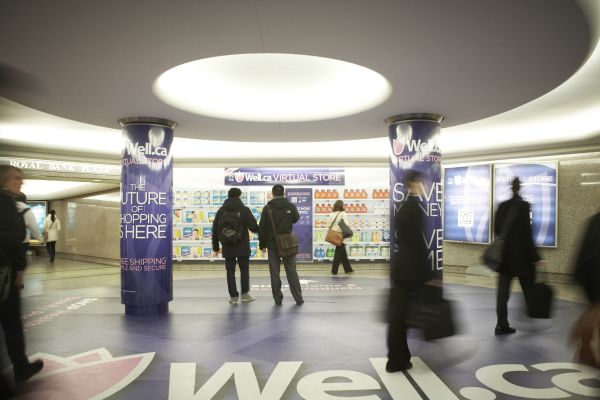Why let the internet and retail stores hog consumers when you can use vacant walls to do your selling?
Mashing mobile and retail together for a limited-time only, Well.ca (a Canadian online store that focuses on health, beauty, personal care and household products) has launched what it says is the first virtual shopping wall in North America.
The wall, located outside the Toronto Union Station TTC subway stop, is designed to provide on-the-go commuters with queue-less shopping. Its virtual shelves hold products from P&G brands such as Tide, Crest, Head and Shoulders and Pampers. To make a purchase, the on-site shopper must download the Well.ca app, scan the QR code that sits below the image of the product on the wall, and wait for the items to arrive via free delivery the next day.
This unique use of QR code technology may turn out to be a show-stopper at the station, with early adopters stopping to try it out, but Paige Malling, VP of marketing, Well.ca, tells MiC that the intended target audience of moms living in the city will likely be the ones getting the most practical use out of it.
Malling says that women with children after a long day of work don’t necessarily want to carry large diaper boxes. They’ll be attracted to the idea of being able to avoid an uncomfortable commute home and check off the bulky items on their shopping list by scanning a wall, she says.
In different areas in the underground PATH in Toronto, large-scale ads have been placed to direct pedestrians to the virtual wall, she says, adding that there will also be a social media plug to create additional hype. Media and creative for the wall were done in-house with Brandfire working on the OOH ads, she says.
If this execution sounds familiar, it’s probably because you’ve seen reports on Tesco’s Korean chain Homeplus subway wall that did virtually (no pun intended) the same thing. Malling admits that the grocery wall that ran in the East was one of many tech inspirations for the wall in Toronto, and that the notion of being the first Canadian retailer to delve into mobile shopping this way spurred the e-commerce site to launch the wall.
“We see that mobile sales are starting to expand for us,” she says. “Currently over 15% of our sales are coming through mobile and we know that this will increase exponentially over the next 12 months. And we wanted to be the first to bring an interesting retail mobile execution [like this] to Canada.”
The wall, which will be up until April 30, can be scanned using either an iPhone, Android, Blackberry or Windows Phone.
Kirk Cavell, mobile strategist, Mobext Mobile Marketing and Communications, tells MiC he is excited to see this execution come to Canada.
“It’s a great example of mobile fused with traditional OOH to provide something functional and time-saving for consumers,” he says. “Adoption and usage will be the ultimate gauge of success, which will rely heavily on the number of barriers between seeing the poster and getting the product delivered to the consumer’s door. The data created by this campaign would be of extreme interest as well. Media data, married to mobile sales and traditional online sales for multi-device users with the same Well.ca account, could paint a really interesting picture of behaviour and purchase habits for a very desirable demo for marketers.”
























